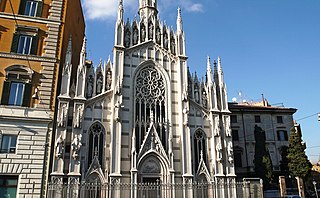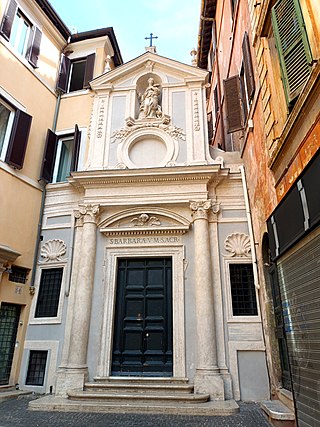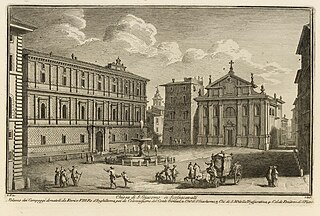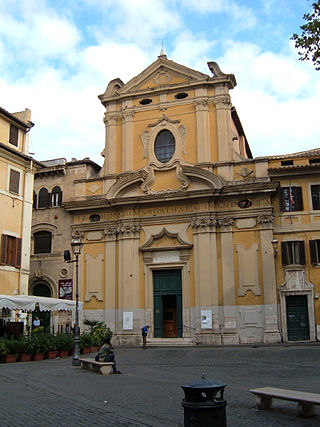
Santa Caterina a Magnanapoli is a baroque church dedicated to St. Catherine of Siena on Largo Magnanapoli on the slopes of the Quirinal Hill in Rome.

Sant'Eligio degli Orefici is a church in Rome, Italy. It is located in the rione Regola, near via Giulia, on a corner of the via of the same name that ends below the Lungotevere dei Tebaldi, a few blocks northwest of the Palazzo Farnese.

The Basilica of Saint Anthony of Padua al Laterano is a Roman Catholic titular church in Rome on Via Merulana, one block from the Obelisk of St. John Lateran. It was built for the Order of Friars Minor, who needed a new home after they were moved from Santa Maria in Ara Coeli to allow the construction of the Victor Emmanuel II Monument.

Santa Maria della Quercia is a Roman Catholic church located on the piazza of the same name, one block southeast of the Palazzo Farnese in the Rione (district) of Regola of central Rome, Italy.

The Chiesa di Santa Rita da Cascia in Campitelli is a deconsecrated church in Rome (Italy), in the rione Sant'Angelo; it is located in Via Montanara, at the crossroad with Via del Teatro Marcello. The church formerly rose on the preexisting church of San Biagio de Mercato, dating at least to the 11th-century. The remains of St Blaise putatively were discovered during the dismantling of Santa Rita.

Sacro Cuore di Gesù in Prati, also known as Sacro Cuore del Suffragio, is a catholic church in the centre of Rome (Italy), rising in the rione Prati, hosting the parish with the same name, entrusted to the Missionaries of the Sacred Heart.

Santa Maria Annunziata in Borgo, popularly known as Nunziatina, is an oratory of Rome (Italy), in the rione Borgo, facing on Lungotevere Vaticano.

Santo Spirito dei Napoletani is a Roman Catholic church on via Giulia, in the Regola rione of Rome. It was the national church of the Kingdom of the Two Sicilies and is now the regional church for Campania.

San Giovanni Battista dei Genovesi is a Roman Catholic church on via Anicia in the Trastevere district of Rome. It is the regional church for Genoa.

Santissimo Sudario all'Argentina or Santissimo Sudario dei Piemontesi is a church in Rome, sited on the via del Sudario in the Sant'Eustachio district. It is the subsidiary church of the military orders in Italy. It was also once the national church of the Kingdom of Sardinia and is now the regional church for Piedmont and Sardinia. It houses a replica of the Turin Shroud.

San Giovanni Decollato is a Roman Catholic church in Rome, sited on via di San Giovanni Decollato in the Ripa rione, a narrow road named after the church. Its construction took most of the 16th century.

Santa Rita da Cascia alle Vergini is a Roman Catholic church in Rome, sited at the corner of Via delle Vergini and Via dell’Umiltà. Diagonal from the church on Via delle Vergini is the Teatro Quirino.

Santa Maria della Concezione is a church in Rome, located on Piazza Campo Marzio in the Campo Marzio rione. It serves as the national church in Rome for Syriac Catholics.

San Biagio della Pagnotta or San Biagio degli Armeni is a church in Rome, in the Ponte district, on via Giulia, near Palazzo Sacchetti. It is dedicated to Saint Blaise and is the national church of the Armenian community in Rome.

San Salvatore alle Coppelle is a church in Rome, on piazza delle Coppelle in the Sant'Eustachio district.

Natività di Gesù is a church on Piazza Pasquino in the Parione rione of Rome. It is the national church in Rome of the Democratic Republic of Congo.

Santa Barbara dei Librai is a small Roman Catholic church in Rome, Italy. It was once known as Santa Barbara alla Regola after the rione in which it was located. Today it now considered within the rione of Parione, near the Campo de' Fiori.

San Giacomo Scossacavalli was a church in Rome important for historical and artistic reasons. The church, facing the Piazza Scossacavalli, was built during the early Middle Ages and since the early 16th century hosted a confraternity which commissioned Renaissance architect Antonio da Sangallo the Younger to build a new shrine. This was richly decorated with frescoes, painted by mannerist artist Giovanni Battista Ricci and his students. The church was demolished in 1937, when Via della Conciliazione was built and the piazza and central part of the Borgo rione were demolished. Many decorative elements still exist, since they were preserved from demolition.

Santa Maria in Monterone is a Roman Catholic church in Rome, Italy. Its suffix originates from the Sienese Monteroni family, whose patronage rebuilt the church and built a small hospice next to it for pilgrims from Siena. It is located on Via Santa Maria in Monterone in the Sant'Eustachio rione. Next to the church is a Redemptorist monastery, whose clergy manage the church.

Sant'Agata in Trastevere is one of the churches of Rome, located in the Trastevere district, at Largo San Giovanni de Matha, 91.





















